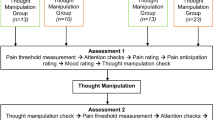Abstract
This study examined the effects of thought suppression, prior to an experimental pain procedure, on subsequent pain experience. The study also examined the role of thought intrusions in mediating the relation between (1) thought suppression and pain, and (2) catastrophizing and pain. Catastrophizers (n = 34) and noncatastrophizers (n = 36) made pain ratings while one arm was immersed in ice water. Prior to the ice water immersion, half the participants were asked to suppress procedure-related thoughts, and the remainder were asked to record their ongoing thoughts. The results showed that thought suppression and catastrophizing were associated with heightened pain experience. The frequency of thought intrusions mediated the relation between suppression condition and pain, but not between catastrophizing and pain. The discussion addresses the mechanisms by which thought intrusions may contribute to pain experience.
Similar content being viewed by others
REFERENCES
Beck, A. T., Ward, C., Mendelson, M., Mock, J., & Erbaugh, J. (1961). An inventory for measuring depression. Archives of General Psychiatry, 4, 561–571.
Cioffi, D. (1991). Beyond attentional strategies: A cognitive-perceptual model of somatic interpretation. Psychological Bulletin, 109, 25–41.
Cioffi, D. (1994). Sensate body, directive mind: Physical sensations and mental control. In D. Wegner and J. W. Pennebaker (Eds.), Handbook of mental control. Englewood Cliffs, NJ: Prentice-Hall.
Cioffi, D., & Holloway, J. (1993). Delayed costs of suppressed pain. Journal of Personality and Social Psychology, 64, 274–282.
Clark D. A., & de Silva, P. (1985). The nature of depressive and anxious, intrusive thoughts: Distinct or uniform phenomena? Behaviour Research and Therapy, 23, 383–393.
Haaga, D. A. F. (1992). Catastrophizing, confounds, and depression: A comment on Sullivan and D'Eon (1990). Journal of Abnormal Psychology, 101, 206–207.
Heyneman, N. E., Fremouw, W. J., Gano, D., Kirkland, F., & Heiden, L. (1990). Individual differences and the effectiveness of different coping strategies for pain. Cognitive Therapy and Research, 14, 63–77.
Leventhal, H., & Nerenz, D. R. (1983). A model for stress research with some implications for the control of stress disorders. In D. Meichenbaum & M. E. Jaremko (Eds.), Stress Reduction and Prevention. New York: Plenum Press.
Levine, F. M., Krass, S. M., Padawer, W. J. (1993). Failure hurts: The effects of stress due to difficult tasks and failure feedback on pain report. Pain, 54, 335–340.
Pennebaker, J. W. (1982). The psychology of physical symptoms. New York: Springer-Verlag.
Pennebaker, J. W., & Lightner, J. M. (1980). Competition of internal and external information in an exercise setting. Journal of Personality and Social Psychology, 39, 165–174.
Schwarz, N., & Bless, H. (1991). Happy and mindless, but sad and smart? The impact of affective states on analytic reasoning. In J. P. Forgas (Ed.), Emotion and social judgments. New York: Pergamon Press.
Schwarz, N., & Clore, G. L. (1988). How do I feel about it? Informative functions of affective states. In K. Fiedler & J. Forgas (Eds.), Affect, cognition, and social behavior. Toronto: Hogrefe.
Spanos, N. P., Radtke-Bodorik, H. L., Ferguson, J. D., & Jones, B. (1979). The effects of hypnotic susceptibility, suggestions for analgesia, and utilization of cognitive strategies on the reduction of pain. Journal of Abnormal Psychology, 88, 282–292.
Spielberger, C. D., Gorsuch, R. L., & Lushene, R. E. (1970). Manual for the State-Trait Anxiety Inventory. Palo Alto, CA: Consulting Psychologists Press.
Sullivan, M. J. L., Bishop, S., & Pivik, J. (1995). The Pain Catastrophizing Scale: Development and validation. Psychological Assessment, 7, 524–532.
Sullivan, M. J. L., & D'Eon, J. (1990). Relation between catastrophizing and depression in chronic pain patients. Journal of Abnormal Psychology, 99, 260–263.
Turk, D. C., Meichenbaum, D., & Genest, M. (1983). Pain and behavioral medicine: A cognitive behavioral perspective. New York: Guilford Press.
Turk, D. C., & Rudy, T. E. (1992). Cognitive factors and persistent pain: A glimpse into Pandora's box. Cognitive Therapy and Research, 16, 99–122.
Wegner, D. M. (1992). You can't always think what you want: Problems in the suppression of unwanted thoughts. In M. Zanna (Ed.), Advances in experimental social psychology (Vol. 25, pp. 193–225). San Diego, CA: Academic Press.
Wegner, D. M. (1994). Ironic processes of mental control. Psychological Review, 101, 34–52.
Wegner, D. M., Schneider, D., Carter, S. R., & White, T. L. (1987). Paradoxical effects of thought suppression. Journal of Personality and Social Psychology, 53, 5–13.
Wells, A., & Matthews, G. (1994). Attention and emotion: A clinical perspective. Hove, UK: Erlbaum.
Wenzlaff, R. M., Wegner, D. M., & Roper, D. W. (1988). Depression and mental control: The resurgence of unwanted negative thoughts. Journal of Personality and Social Psychology, 55, 882–892.
Wolf, S., & Hardy, J. D. (1943). Studies on pain: Observations of pain due to local cooling and on factors involved in the “cold pressor” effect. Research Publications of the Association for Research on Nervous and Mental Disease, 23, 123–142.
Author information
Authors and Affiliations
Rights and permissions
About this article
Cite this article
Sullivan, M.J.L., Rouse, D., Bishop, S. et al. Thought Suppression, Catastrophizing, and Pain. Cognitive Therapy and Research 21, 555–568 (1997). https://doi.org/10.1023/A:1021809519002
Issue Date:
DOI: https://doi.org/10.1023/A:1021809519002



